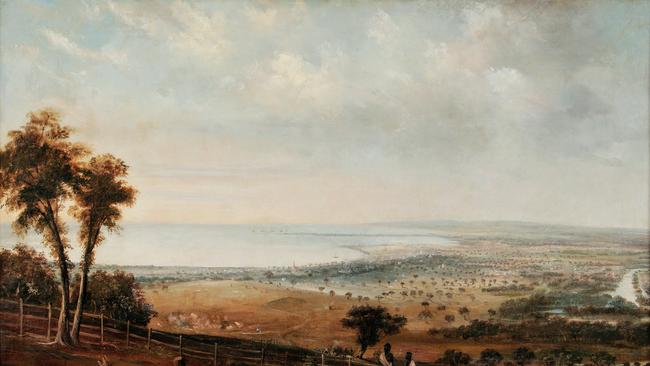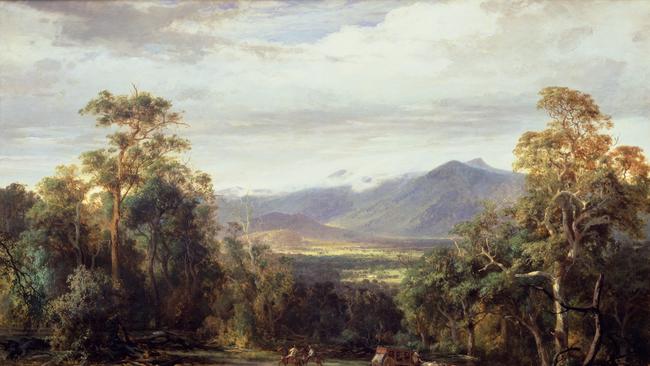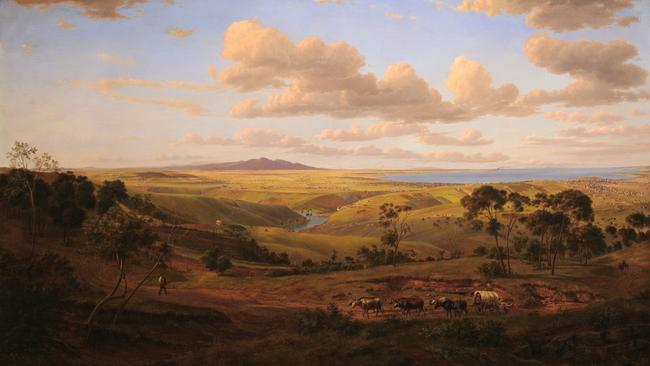Why some of Australia’s best art can be found in the regions
Some colonial works chart the nascent colony, as recorded by artists trained in the best of European traditions.

The Changing sky
Geelong Art Gallery until July 16
This small exhibition, which was conceived in part as a prelude to the Clarice Beckett show reviewed a few weeks ago, is in fact an opportunity to look more closely at a few other works from the collection, and particularly at several quite large paintings of the colonial period – especially as most of the other important works have had to be taken down temporarily to accommodate Beckett.
Some of these are famous pictures in Australian art history, like Frederick McCubbin’s A Bush Burial (1890). Geelong, like Bendigo, Ballarat and even smaller cities like Castlemaine, because of their early prosperity in the 19th century, were able to form significant collections from an early date; and when a gallery already has a substantial collection it is much more likely to attract further donations and bequests.
Geelong Art Gallery was opened in 1900 and moved to its present building in 1915; that building has been extended several times since, and there are now plans for a massive new edifice which will undoubtedly provide more space for the collection and for special exhibitions, although it may lack some of the charm and historical character of the present building. We just have to hope that the new space really is used to display the collection, rather than, as so often, to accommodate fashionable contemporary art.
The Changing Sky, which occupies a large gallery leading into the Beckett exhibition, is heavily weighted in quality to the left side, and the pictures on the right for the most part look thin and superficial in comparison. With the distance of time, postwar artists of last century frequently produce this sort of disappointing impression; they had one idea or thought that one dramatic effect would make their work strong and memorable, but looking at them again after half a century or so they often seem thin and weak.
The first painting we encounter in the exhibition is Geelong from Mr Hiatt’s, Barrabool Hills (1851) by a figure not particularly well known in the history of 19th century art, William Duke (1815-53), who arrived in Australia in 1840 and worked as a painter of portraits, theatre backdrops and dioramas before dying in Melbourne at the early age of 38.
Geelong itself had only been officially named three years earlier, in 1837, by Governor Bourke, for it was still a part of the vast colony of NSW.

Duke’s painting is a large topographical landscape, looking east from a viewpoint in the Barrabool Hills to the west of the city, over Geelong and Corio Bay. From Point Henry in the distance extends the long sandbar which prevented ocean-going ships from entering Geelong Harbour until a passage was dredged in the 1890s; large vessels, as we see in the painting, had to anchor beyond the sandbar while their cargo was unloaded on to lighters. The town itself is still very modest in size, but is marked by the spire of Christ Church Geelong, built by Edmund Blacket and consecrated in 1847, close to the centre of the composition.
By a curious paradox of topographic views, the foreground of the painting represents what is really the remote background of the ostensible subject – incidents of life on the fringes of the new settlement which would be quite literally invisible from the town itself. Here the foreground is divided off from the rest of the composition by a wooden fence, behind which a flock of sheep is visible. Outside the fence are several tree stumps, one of a tree that has died naturally, the others cut down, presumably to make the posts and rails.
Also outside, as in the foreground of many colonial paintings, are two Aboriginal men, one standing and the other sitting on a stump. Their presence reminds us that they have been marginalised by the spread of a colony that has occupied part of their traditional lands, but it also suggests that they are co-existing with the new settlers. They are dignified figures with hunting spears, so they are still living their traditional lives, only now they have the help of a dog acquired from the settlers and blankets which they wear like the robes of the ancients.
It would be easy to interpret their position outside the white settlers’ fence as signifying their exclusion from the new order, but as so often it pays to resist the obvious conclusions and look more carefully: for in fact there is an Aboriginal camp just inside the fence, sheltering under a tree with a couple more figures and a fire. The smoke from this campfire suggestively matches the smoke from a little house further down the hill, a symbol of home as old as Homer.
Next are two paintings by Eugene von Guérard, the larger of which is a View of Geelong painted in 1856, thus only five years after Duke’s picture, although by now the landscape of Victoria was being rapidly transformed by the new wealth of the gold rush. Von Guérard, who has been the object of important art-historical study in recent decades and is now acknowledged as one of the most important Australian painters of the 19th century, had grown up in Vienna and spent 12 years in Rome and Naples as well as studying at the Academy in Duesseldorf before coming to Australia.
As heir to both the precision of neoclassical painting and the romantic sense of the sublime, and yet also imbued with the scientific spirit of Alexander von Humboldt who emphasised the paramount importance of truth, von Guérard was in a unique position to paint exquisite and yet highly accurate views of the new world he found in Australia. Here the outlook, as the label informs us, is northeasterly from the village of Ceres, “across the You Yangs and the even more distant Dandenong Ranges”.
The vista is magnificent, but here too the foreground is of great interest. There is no fence, but the foreground is marked off from the view beyond by a dirt road running parallel to the picture plane. On the left, a single man walks along this road with a pick over his shoulder; on the right, coming in the opposite direction, are a couple of individuals in a covered wagon pulled by six oxen.
No doubt they are miners, because Geelong was at this period the main port for miners travelling to the Central Highlands region and Ballarat, although the railway line from Geelong to Ballarat was not opened until 1862.
In the background, the city appears to be noticeably bigger and more established than in the earlier view – it was, as already noted, growing rapidly during the gold rush of the 1850s – and von Guerard, with his eye for detail, clearly marks the neat patchwork of cultivated fields behind the growing city. In the middle distance, near a field with grazing cattle, we once again discover the motif of a little cottage with a smoking chimney; here it is an image of the intimate experience of dwelling in the new land, in contrast with the public dimension of the expanding city.
The next picture, On the Woods Point Road (1872), is by the artist who by this time was supplanting von Guérard in Melbourne taste: Abram Louis Buvelot, a Swiss who had spent years in Brazil but who brought to Australia the Barbizon style of plein-air painting developed in the 1830s by Corot, Rousseau and others, and named for one of their favourite painting spots, the forest of Fontainebleau which by mid-century was a short train ride from Paris.
Buvelot’s style was looser and less formal than von Guérard’s, and in the decade that followed he would be admired as a precursor by the emerging Heidelberg school of Roberts, Streeton and McCubbin, although this entailed a corresponding depreciation of all the significant colonial painters who had preceded him.
The whole conception of Buvelot’s painting is different, and seems to reflect another phase in the evolution of the colonial sensibility. Instead of von Guérard’s high viewpoint over a vast topographical vista and the emphasis on the growth of the new settlement, Buvelot adopts what appears at first sight to be a low viewpoint, as in a Dutch landscape, with a distant prospect of high mountains in the background. There is a substantial homestead far away near the centre of the composition, but otherwise much less emphasis on the architectural evidence of settlement.

When we look more closely, we find that Buvelot’s viewpoint is more elevated than it appears at first sight, because the flat foreground – what used to be called a “terrace” in landscape theory – is much broader than the relatively narrow ridge in von Guérard. We are in fact on the top of a hill looking down, between clumps of trees that recall the Barbizon school, into a valley in the middle distance.
The landscape appears almost empty apart from the house already noted, but the sense of settlement and occupation is almost more forcibly conveyed by the wide road that occupied most of the foreground terrace, and which drives at right angles to the picture plane, straight into the landscape. Two men on horseback talk near the centre of the composition, while a stagecoach is starting to go downhill on the right; the ox-drawn wagon of a group of miners has already been replaced by a regular system of public transport.
It would have been fascinating to follow these themes into the art of the last quarter of the 19th century and the pictures of the Heidelberg School, but unfortunately that whole crucial section of the story is missing, and the next picture in date is a beach landscape by Walter Withers from 1901: a pleasant view, but one in which familiarity is now as unquestioning as if we were looking at a beach in England.
Arthur Merric Boyd’s Mount Wellington (1906) is also a fine picture, but – apart from the native trees on the right – could almost be a view of Scotland. There’s nothing wrong with that in itself, but it is simply less interesting than the colonial and later 19th-century paintings that are visibly dealing with the many dimensions – practical, ethical and aesthetic – of making a home in a new land.
There are indeed two beautiful works by Arthur Streeton, View up the valley (1920), a dramatic study of the Grampians with a sunlit rock face in the foreground, and Ocean blue, Lorne (1921), a fresh and spontaneous view down from a hilltop path to waves lapping on deserted beach. Neither of these paintings is like the work for which he made his name in the 1880s and 90s, but they do represent a sense of discovery – in this case the artist’s rediscovery of his native land after his long residence in England, far from the sources of his deepest inspiration.
The Changing sky
Geelong Art Gallery until July 16




To join the conversation, please log in. Don't have an account? Register
Join the conversation, you are commenting as Logout